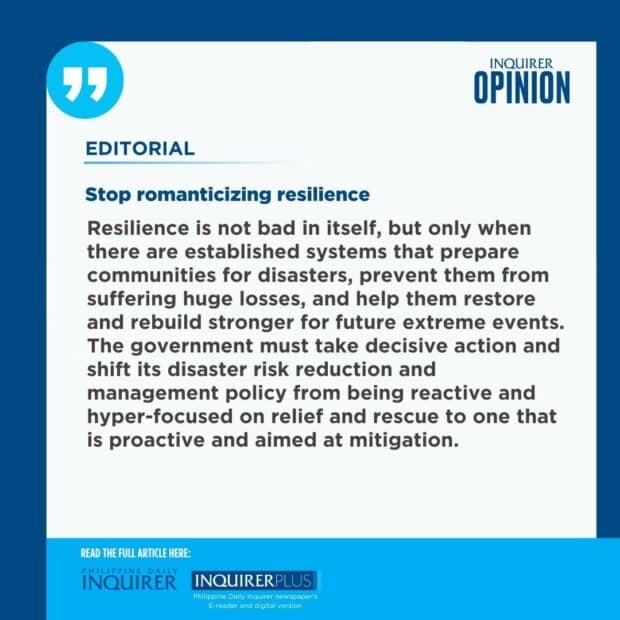
Resilience is the most abused and overused term to describe what helps Filipinos survive calamities. The word has started to sound like a backhanded compliment because being resilient for many simply implies that it is the only way for them to survive difficult situations in the absence of long-term, sustainable solutions.
As Albay Rep. Joey Salceda found out when he wrote on his Facebook page in a now-deleted post, “Good day Global Albay. We are resilient,” resiliency is no longer viewed positively especially when it only exposes and highlights the abject failure of the government to address perennial problems such as heavy flooding during typhoons. And then there was Camarines Sur Rep. LRay Villafuerte who said residents in his jurisdiction—one of the areas hardest hit by Severe Tropical Storm “Kristine”—were already “accustomed” to typhoons.
Kristine dumped two months’ worth of rain in several provinces affecting 2.3 million Filipinos; over 40 have been reported dead and about 250,000 displaced. The Department of Agriculture estimated damage to crops amounting to P143 million. Many areas including Cavite, Quezon, Samar, and Bicol have been placed under a state of calamity. No one should be accustomed to such disasters.
Most disaster-prone
That the Philippines is the most disaster-prone country in the world has been established by the World Risk Index, which has ranked it at the top for the third consecutive year due to its exposure and vulnerability to natural disasters, as well as the lack of coping and adaptive capacities. But aside from these factors, Katrin Radtke, a senior researcher specializing in disaster preparedness at the Ruhr University Bochum in Germany, said poverty and high levels of corruption hugely contribute to the country’s risk ranking.
As Kristine battered Luzon and the Visayas, viral social media posts laid bare the plight of many Filipinos: desperate appeals for help by affected residents trapped in their homes or forced to climb to the roof to escape the rising floods, many more braving waist-deep or even deeper waters to save family, property, or pets—scenes reminiscent of many previous typhoons that had hit the country. At one point, Bicol’s Regional Disaster Risk Reduction and Management Council announced that its rescuers could no longer respond to the numerous calls for rescue due to the shortage of rubber boats and advised residents to look for safe areas (“humanap muna ng puwedeng ligtas na lugar”). Even President Marcos said he felt a “little helpless” and that all the government could do was “sit tight, wait, hope, pray that there’s not too much damage, that there are no casualties.”
Reactionary mindset
The government, given the resources it has at its disposal, is the last institution that should feel helpless. It has billions of funds allocated for projects that are meant to avoid the very situations Filipinos found themselves in during the onslaught of Kristine. But, as cited in last Tuesday’s editorial, an Oxfam report has found that 70 percent of funds meant for mitigating disasters are almost untouched. This reflects the reactionary mindset prevalent among government officials, which must change.
Resilience is not bad in itself, but only when there are established systems that prepare communities for disasters, prevent them from suffering huge losses, and help them restore and rebuild stronger for future extreme events. The government must take decisive action and shift its disaster risk reduction and management (DRRM) policy from being reactive and hyper-focused on relief and rescue to one that is proactive and aimed at mitigation. This could include tapping technology to help communities anticipate the amount of rainfall and determine hazardous and flood-prone areas, provide vulnerable households with survival kits, and build better flood-control infrastructure, stronger dwellings, and permanent shelters so there won’t be any need to resort to using schools or basketball courts as temporary evacuation centers.
Clear environmental platforms
It must also stop development projects that are destructive to nature, specifically, forests and mangroves, which act as shields against typhoons and tsunamis. Sierra Madre, for example, an Isabela official believes, spared the province from the brunt of Kristine’s wrath. This makes the protection of mountain ranges and forests from denudation and deforestation of paramount importance.
Filipinos are not helpless either. In the coming midterm elections, they can choose to vote for leaders who have clear environmental platforms. Do they have sound DRRM plans or will they ride their version of Noah’s Ark to distribute cash to their desperate constituents in the middle of the floods to cover up for the lack of disaster preparedness? Ecological issues are as equally important as economic matters and those running for public office must be scrutinized on where they stand on them. This vicious cycle that enables politicians to exploit and romanticize people’s resilience must end.

